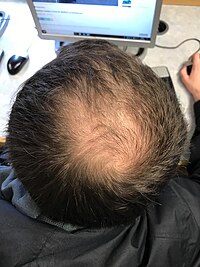
Photo from wikipedia
Introduction: Hair loss is a common and distressing clinical complaint in the dermatology clinics. Common causes of hair loss in children include alopecia areata, tinea capitis, traction alopecia, and trichotillomania.… Click to show full abstract
Introduction: Hair loss is a common and distressing clinical complaint in the dermatology clinics. Common causes of hair loss in children include alopecia areata, tinea capitis, traction alopecia, and trichotillomania. Newly, trichoscopy allows differential diagnosis of hair loss in most cases and allows visualization of hair shafts and scalps without the need of removing hair. Objective: The main objective is to compare the different trichoscopic features of common causes of patchy hair in children loss including tinea capitis, alopecia areata, traction alopecia, and trichotillomania. Patients and Methods: This study included 134 patients, 63 patients with tinea capitis, 38 patients with alopecia areata, 18 patients with traction alopecia, and 15 patients with trichotillomania. The diagnostic tools for the diagnosis of hair loss problem included a detailed history, evaluation of the child's hair and scalp, fungal scrapping, and trichoscopy. Results: Tinea capitis was the most common, and the trichoscopic features were comma-shaped hairs, corkscrew hairs, short broken hairs, and interrupted hairs. While in alopecia areata patients, the most specific features were yellow dots and black dots, microexclamation mark, hair shafts with variable thickness, and vellus hairs, with uncommon features included: monilethrix, coiled, zigzag, and tulip hairs. Trichoscopy of trichotillomania showed hair with fraying of ends, breakage at different lengths, short and coiled hairs, and amorphous hair residues. The trichoscopic features of traction alopecia were similar to those of trichotillomania. However, flame hairs and coiled hairs were less common. Conclusions: Trichoscopy is a noninvasive method of examining hair and scalp. It allows differential diagnosis of hair loss in most cases.
Journal Title: International Journal of Trichology
Year Published: 2018
Link to full text (if available)
Share on Social Media: Sign Up to like & get
recommendations!